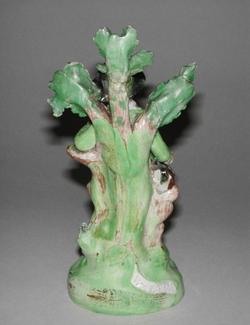Current Location: In storage
Titles
Harvester
Maker(s)
Production:
Walton, John
Entities
Categories
Description
Earthenware, moulded and modelled, lead glazed and painted with polychrome enamels.
Earthenware figure carrying a small barrel in his right hand, leaning on a scythe. He stands on an irregular green mound against a tree with three branches. The man wears a black hat, pale green tunic, black knee buckles, white stockings and black shoes. The back is flattened, but shaped and painted. The underside of the base is open, showing the hollow interior.
Notes
History note: Given by Captain W. M. Clarke
Legal notes
Given by Captain W. M. Clarke
Measurements and weight
Depth: 6.5 cm
Height: 18 cm
Width: 8 cm
Acquisition and important dates
Method of acquisition: Given
(1944)
by
Clarke. W. M., Capt
Dating
19th Century
Circa
1810
CE
-
Circa
1820
CE
Note
Bocage figures and groups, which feature stylised leafy trees, are particularly associated with John Walton of Burslem, who is listed in local directories from c.1818-1835. Walton made a number of versions of this figure. Other potters also made figures in this style, often copying designs and other features from each other.
Pearlware earthenware figures decorated with enamels were in production by 1780. They were generally made at smaller potteries and are rarely marked. A cheaper alternative to porcelain figures, they drew on a variety of 3-D sources, including sculpture and porcelain figures. Classical, biblical, mythological and literary subjects were popular, as were animals and representations of rural life, seasons and trades. From the early 19th Century, scenes from everyday life and topical events were also common. These early figures are moulded, perhaps with moulded or modelled parts added, the bases often formed separately. After around 1810-1820, bocage (stylised foliage) is common and figures are often more vibrantly coloured. By c.1835, these early methods had largely given way to three-part press-moulding, which enabled cheaper, mass production of figures for a growing market.
People, subjects and objects depicted
Components of the work
Decoration
composed of
enamels
lead-glaze
Parts
Materials used in production
Earthenware
Techniques used in production
Moulding
Inscription or legends present
- Text: WALTON
- Location: Lower back of figure
- Method of creation: Impressed into relief scroll
- Type: Mark
References and bibliographic entries
Identification numbers
Accession number: EC.2-1944
Primary reference Number: 76906
Stable URI
Audit data
Created: Saturday 6 August 2011
Updated: Monday 25 March 2024
Last processed: Tuesday 29 July 2025
Associated departments & institutions
Owner or interested party:
The Fitzwilliam Museum
Associated department:
Applied Arts





